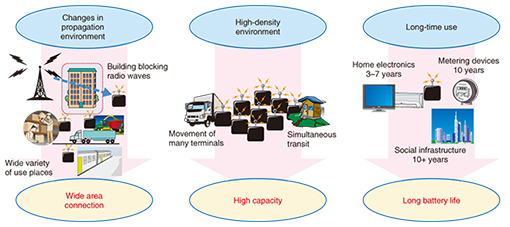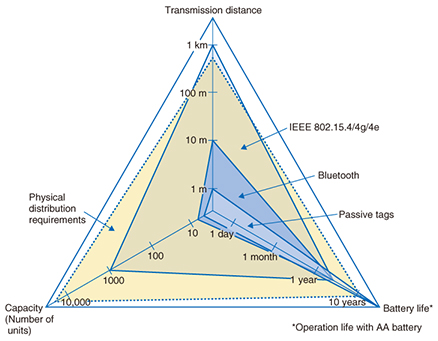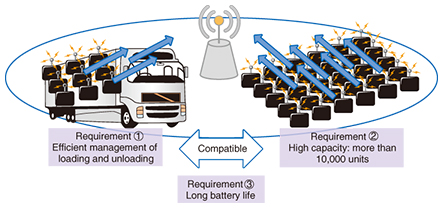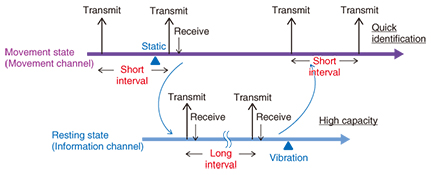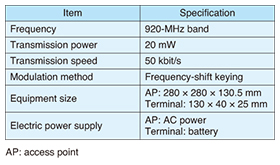 |
|||||||||||||||
|
|
|||||||||||||||
|
Regular Articles Vol. 13, No. 8, pp. 60–65, Aug. 2015. https://doi.org/10.53829/ntr201508ra3 Development of High-capacity Protocol for M2M Services and Its Application to a Pallet Management SystemAbstractNTT Network Innovation Laboratories has developed a high-capacity protocol for the 920-MHz band in order to enhance the effectiveness and accelerate the adoption of machine-to-machine (M2M) services. This protocol can detect the movement of hundreds of terminals and manage more than 10,000 terminals. The protocol is applied to physical distribution systems in which very large inventories need to be controlled. It offers efficient management of loading/unloading activities. The protocol was commercialized as a pallet management system in fiscal year 2015. In this article, we describe the protocol and explain how we verified its performance in tests conducted in an actual goods distribution center. Keywords: M2M, high-capacity, physical distribution 1. IntroductionMachine to machine (M2M) communication systems have recently been attracting a lot of attention. The concept of the Internet of Things (IoT) involves connecting everything around us to the Internet. The information that comes from these multiple components will be collected and analyzed in a network. This information will then be utilized as big data and is expected to lead to the creation of new value services [1]. In addition, the infrastructure for M2M services is being improved. For example, the Association of Radio Industries and Businesses (ARIB) issued standard STD-T108 [2] for 920-MHz band use in 2012. We have developed a high-capacity protocol that supports ARIB STD-T108. As a precursor of IoT/M2M, we applied the protocol to a pallet management system and completed initial trials. 2. M2M service requirementsM2M services create different wireless loads from those of personal communication devices such as cellular phones. Most M2M service terminals cannot move independently and thus remain stationary for long periods. M2M systems must therefore be designed in consideration of these attributes. The typical communication environment desired for M2M services is depicted in Fig. 1. We assume the environment has the following characteristics.
(1) Wide area: Even if the wireless environment is inadequate, a terminal cannot be moved easily. For example, the access point and terminal may not have a direct line of sight. Thus, communication must be established even in difficult circumstances. (2) High capacity: It is assumed that many terminals are concentrated at one access point or that they transmit simultaneously after a disaster. Therefore, it is necessary to be able to communicate with many terminals. (3) Long battery life: It is assumed that a terminal has no AC (alternating current) power supply and that some terminals will be installed in the social infrastructure, for example, on bridges and water pipes, and that their operation will be managed without changing the battery. Therefore, a long battery life must be achieved while maintaining the low power consumption. Various wireless systems have been developed for M2M services in consideration of these requirements. The characteristics of wireless systems that can be applied to M2M services are shown in Fig. 2. The IMS (Industrial, Scientific and Medical) bands are in very heavy use, for example, for passive radio frequency identification (RFID) tags, Bluetooth*, and IEEE (Institute of Electrical and Electronics Engineers) 802.15.4/4g [3]/4e [4], the standards specifying the physical layer for low-rate wireless personal area networks.
Passive RFID tags have a short transmission distance, about 1 m, but they require no batteries. Thus, the usage scenario is to apply them as a substitute for barcodes in managing the logistics of goods. The Bluetooth transmission distance is about 10 m, and higher communication speeds are possible compared with other wireless systems used for M2M services, although the number of connected terminals is limited to 10. Bluetooth LE (low energy) specializes in low power consumption. Usage scenarios include applying it in wearable and healthcare related devices. IEEE 802.15.4/4g/4e specify a transmission speed of about 100 kbit/s, a maximum transmission distance of 1 km, and a capacity of about 1000 terminals. Unfortunately, the battery life is only about one year. Thus, the usage scenarios include metering devices, as stated in Wi-SUN (Wireless Smart Utility Network) alliance standards. In contrast, the dotted line in Fig. 2 delineates the requirements of the pallet management system assumed here. This system must accommodate tens of thousands of pallets at a depot with only a few access points. Thus, the wireless distance is hundreds of meters, and the system capacity is more than 10,000 terminals. Moreover, the battery lifetime should be at least 10 years, roughly the lifetime of a pallet. In addition, rapid recognition of the loading and unloading of hundreds of pallets carried by trucks must be achieved, as indicated in Fig. 3. A new innovative wireless system is necessary to meet these requirements.
3. High-capacity protocol technologyOur solution is a new high-capacity protocol that can connect tens of thousands of terminals and manage the movement of hundreds of terminals. Moreover, it enables a battery lifetime that can exceed 10 years. The protocol is outlined in Fig. 4.
The terminal has two states, a resting state and a movement state. The resting state indicates that the terminal is stationary. The movement state is triggered by the terminal’s vibration sensor and indicates that the pallet is being transferred by a forklift or truck. The terminal transmits beacon packets consisting of a terminal ID, sequence number, and state information of the terminal. The transmission interval of the beacon packet is controlled by the state of the terminal. The beacon transmission interval is set very short in order to quickly identify the movement state. The resting state uses long time periods when transmitting beacon packets in order to accommodate many terminals. In addition, the movement and resting states use different frequencies. For this reason, even if many resting state terminals are present, collision of beacon packets is minimized, and rapid recognition of terminals in the movement state becomes possible. The protocol can be applied to a variety of M2M services with the use of different or additional sensors. For example, if the temperature exceeds or falls below a set threshold, rapid notification is sent. Furthermore, notification of sudden changes in water level, of a river, for example, can be sent quickly. Thus, our approach supports various M2M services by changing the sensor(s) and the beacon transmission interval. 4. Evaluation of pallet management system in practical useWe developed equipment that hosts the aforementioned high-capacity protocol. The key specifications of the wireless equipment are listed in Table 1. The frequency band, transmission power, and other radio specifications are based on STD-T108, the ARIB standard specifications for the 920-MHz band. The transmission speed and modulation method are based on the IEEE 802.15.4g specifications. The access point can handle multiple frequencies through the use of multiple wireless modules and antennas. The terminal is equipped with components including a wireless module, built-in antenna, vibration sensor, and a battery and is roughly the same size as a pack of cigarettes, so it is easy to mount on a pallet.
We applied the protocol in a pallet management system and conducted tests at a depot of UPR Corporation, a collaborative partner. The system configuration is depicted in Fig. 5. Several terminals were installed on pallets, and the other terminals were put in the depot to replicate the resting state. The access point was placed in the depot and was able to connect to the terminals in all locations and at the depot entrance. The access point transferred the beacon packets to a cloud server for pallet management.
Through these tests, we confirmed that the prototype system was able to accommodate more than 10,000 terminals. In addition, we confirmed that the reception probability reached 100% within 3 minutes when the terminal was in a movement state and within 100 m from the access point. Note that the number of terminals that one access point handles can be increased by enlarging the beacon packet interval in a resting state. As a result of these successful tests, commercial operation of a pallet management system using this protocol was commenced at UPR Corporation in April 2015 [5, 6]. 5. ConclusionIn the future, we will work on advancing our research to achieve higher capacity and lower power consumption. Our goal is to achieve an M2M service that offers higher capacity and longer battery life. References
|
|||||||||||||||









